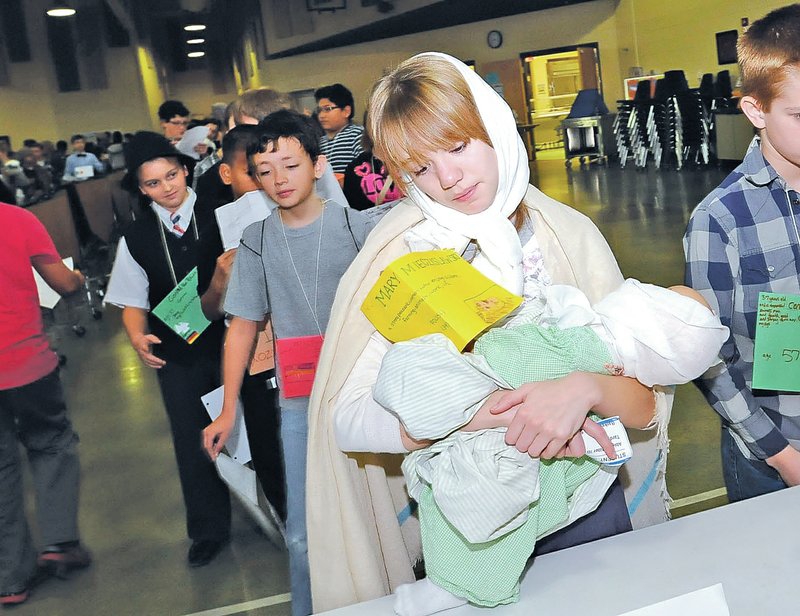BENTONVILLE -- Sophia Soldani admitted being a little surprised she'd been allowed into the U.S., given the character she was playing -- a single mother of four children with a fifth on the way.
Sophia, 11, went by the name of Marya Bolknosky, a 20-year-old Russian immigrant, during Ruth Barker Middle School's annual re-creation of Ellis Island during the early 20th century.
At A Glance (w/logo)
Ellis Island
Ellis Island, N.Y., served as America’s largest immigration station from 1892 to 1954. It processed more than 12 million immigrants. The peak year was 1907, when a little more than 1 million immigrants were processed. About 2 percent of immigrants were denied admission to the country for disease, criminal background or insanity. It’s been estimated nearly 40 percent of all current U.S. citizens can trace at least one of their ancestors to Ellis Island.
Source: History.com
Wednesday's event was the culmination of the sixth grade's study of immigration. Each of the school's 300 sixth-graders was assigned a role as either an immigrant or one of the Ellis Island intake employees. Each role came with a name and certain characteristics.
Students were asked to dress to match their characters. Some carried props such as suitcases and dolls. Immigrants wore a placard indicating their name, nationality, age and characteristics.
Sophia stuffed a jacket under her shirt to represent her character's pregnancy. Her character's baby was due in three weeks, she said.
"I think it would be hard, because I don't have a husband and I only have $13," Sophia said, when asked to imagine her character's life.
The immigrants stood in long lines at each of four stations to be evaluated on their background, vocation, character and health. If their scores were high enough, they were admitted to the country and could advance to take the loyalty oath. If their scores fell short, they had the option of appealing.
The appeals station is where Cayton McKinley worked, playing the role of a German man named Karl Streicher. Most appeals were granted, but not all, Cayton said.
He pointed out a shady character who had committed murder in his native land.
"He's very rich, but we don't want to let murderers in," he said.
When Rachel Senkevech -- playing the part of a Polish opera singer -- approached the appeals table, she told Cayton she had $134 and she could sing. That was good enough for Cayton, who waved her on to the loyalty oath station.
Rachel, 12, wore one of her mother's dresses and a long, green scarf around her head. She had learned at least one lesson from the event.
"It's not always easy to get what you want," Rachel said.
The less fortunate immigrants ended up at the table where officials filled out deportation forms.
Willa Lawson, sixth-grade social studies teacher, said Barker has done the mock Ellis Island event for eight years.
"Hopefully they will have some idea of what it was like for an immigrant at the turn of the 20th century," Lawson said.
The mix of attitudes among the intake employees toward certain nationalities and religions was meant to reflect views of real-life Ellis Island workers during that period, Lawson said.
McKenna Bagley, 11, served as an intake officer at the background station. Her character was supposed to be strict when it came to whom she let in, but she said it was hard not to approve her friends.
"I'm glad we got to do this. It was just really fun to do," McKenna said.
NW News on 12/18/2014
